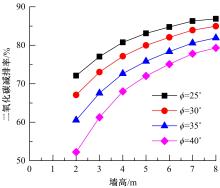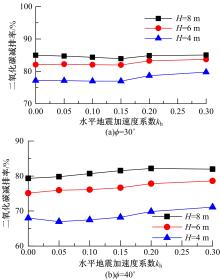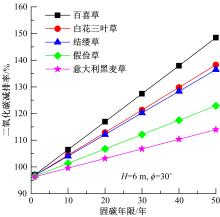吉林大学学报(工学版) ›› 2021, Vol. 51 ›› Issue (2): 631-637.doi: 10.13229/j.cnki.jdxbgxb20191141
• 交通运输工程·土木工程 • 上一篇
加筋土挡墙碳排放计算方法与减排性分析
- 1.河海大学 岩土力学与堤坝工程教育部重点实验室,南京 210098
2.河海大学 岩土工程科学研究所,南京 210098
3.西南交通大学 高速铁路线路工程教育部重点实验室,成都 610031
4.中国电力工程顾问集团 华东电力设计院有限公司,上海 200063
Emission mitigation analysis of geosynthetic⁃reinforced walls
Fei ZHANG1,2( ),Yu-ming ZHU1,2,Shang-chuan YANG3,Shu-mao WANG4
),Yu-ming ZHU1,2,Shang-chuan YANG3,Shu-mao WANG4
- 1.Key Laboratory of Ministry of Education for Geomechanics and Embankment Engineering,Hohai University,Nanjing 210098,China
2.Geotechnical Research Institute,Hohai University,Nanjing 210098,China
3.Key Laboratory of High-speed Railway Engineering,Ministry of Education,Southwest Jiaotong University,Chengdu 610031,China
4.East China Electric Power Design Institute of China Power Engineering Consulting Group,Shanghai 200063,China
摘要:
针对两种形式土工合成材料加筋土挡墙进行基于规范的稳定性加筋设计,并评估其减排性能;通过与传统重力式挡墙对比,分析了不同设计参数对其减排特性的影响规律。相比重力式挡墙,土工合成材料加筋土挡墙的应用至少可以减少50%的碳排放量;得益于加筋土挡墙良好的抗震特性,其减排性随水平地震加速度的增大而增大,但影响程度较小;植物光合作用减排性随固碳年限线性增大,包裹植生式加筋土挡墙运用植被替代面板使其减排率超过90%,当挡墙建成后3~10年便可达到减排率100%,实现绿色生态支护。
中图分类号:
- TU4
| 1 | Solomon S, Plattner G K, Knutti R, et al. Irreversible climate change due to carbon dioxide emissions[J]. PNAS, 2009, 106(6): 1704-1709. |
| 2 | Roger P J, Wigley T, Green C. Dangerous assumptions[J]. Nature, 2008, 452: 531-532. |
| 3 | 王微, 林剑艺, 崔胜辉, 等. 碳足迹分析方法研究综述[J]. 环境科学与技术, 2010, 33(7): 71-78. |
| Wang Wei, Lin Jian-yi, Cui Sheng-hui, et al. An overview of carbon footprint analysis[J]. Environmental Science & Technology, 2010, 33(7): 71-78. | |
| 4 | 牛秀敏. 全要素视角下的中国碳排放效率区域差异性及收敛性研究[D]. 成都: 西南财经大学统计学院, 2016. |
| Niu Xiu-min. Research on reginal difference and convergence of China's carbon emission efficiency from perspective of total factors[D]. Chengdu: School of Statistics, Southwestern University Of Finance And Economics, 2016. | |
| 5 | 陈莎, 崔东阁, 张慧娟. 建筑物碳排放计算方法及案例研究[J].北京工业大学学报, 2016, 42(4): 594-600. |
| Chen Sha, Cui Dong-ge, Zhang Hui-juan. Calculation of carbon dioxide emissions from buildings and case study[J]. Journal of Beijing University of Technology, 2016, 42(4): 594-600. | |
| 6 | 郑晓云, 徐金秀. 基于LCA的装配式建筑全生命周期碳排放研究——以重庆市某轻钢装配式集成别墅为例[J]. 建筑经济, 2019, 40(1): 107-111. |
| Zheng Xiao-yun, Xu Jin-xiu. Research on carbon emissions of assembly building life cycle based on LCA: take a light steel assembly integrated villa in chongqing as an example[J]. Construction Economy, 2019, 40(1): 107-111. | |
| 7 | 陈进杰, 王兴举, 王祥琴, 等. 高速铁路全生命周期碳排放计算[J]. 铁道学报, 2016, 38(12): 47-55. |
| Chen Jin-jie, Wang Xing-ju, Wang Xiang-qin, et al. Calculation of carbon dioxide emissions in the life cycle of high-speed railway[J]. Journal of The China Railway Society, 2016, 38(12): 47-55. | |
| 8 | 宋晓东, 付延冰, 刘恒斌, 等. 基于生命周期评价的高速铁路减排效果[J]. 中南大学学报: 自然科学版, 2014, 45(9): 3301-3307. |
| Song Xiao-dong, Fu Yan-bing, Liu Heng-bin, et al. Carbon dioxide emission reduction of high-speed railway[J]. Journal of Central South University (Science and Technology), 2014, 45(9): 3301-3307. | |
| 9 | 姬文哲. 天津市交通碳排放计算与减排对策研究[D]. 天津: 天津大学管理与经济学部, 2014. |
| Ji Wen-zhe. Research and countermeasures on carbon emission of Tianjin transport[D]. Tianjin: College of Management and Economy, Tianjin University, 2014. | |
| 10 | 陈进杰, 高桂凤, 王兴举, 等. 城市轨道交通全寿命周期能耗计算方法[J]. 交通运输工程学报, 2014, 14(4): 89-97. |
| Chen Jin-jie, Gao Gui-feng, Wang Xing-ju, et al. Calculation method of whole life-cycle energy consumption for urban rail transit[J]. Journal of Traffic and Transportation Engineering, 2014, 14(4): 89-97. | |
| 11 | 黎礼刚, 李凌云, 周紧东, 等. 护岸工程材料综合能耗和碳排放计算及评价[J]. 人民长江, 2012, 43(7): 50-55. |
| Li Li-gang, Li Ling-yun, Zhou Jin-dong, et al. Calculation and evaluation of comprehensive energy consumption and carbon emissions of revetment works materials[J]. Yangtze River, 2012, 43(7): 50-55. | |
| 12 | 徐安, 乔向明, 曹海涛, 等. 在用汽车温室气体CO2排放分布规律及其建模[J]. 吉林大学学报: 工学版, 2010, 40(2): 382-385. |
| Xu An, Qiao Xiang-ming, Cao Hai-tao, et al. Distribution pattern and modeling of in-use vehicle greenhouse gas CO2 emission[J]. Journal of Jilin University (Engineering and Technology Edition), 2010, 40(2): 382-385. | |
| 13 | 陈建峰, 柳军修, 石振明. 软土地基加筋土挡墙数值模拟及稳定性探讨[J]. 岩石力学与工程学报, 2012, 31(9): 1928-1935. |
| Chen Jian-feng, Liu Jun-xiu, Shi Zhen-ming. Numerical simulation and stability discussion of a reinforced soil retaining wall on soft foundation[J]. Chinese Journal of Rock Mechanics and Engineering, 2012, 31(9): 1928-1935. | |
| 14 | 周文洋. 多级加筋土挡墙内部稳定性计算方法研究[D]. 成都: 西南交通大学土木工程学院, 2016. |
| Zhou Wen-yang. Study on internal stability of the multiple stages reinforced soil walls[D]. Chengdu: School of Civil Engineering, Southwest Jiaotong University, 2016. | |
| 15 | Han J, Leshchinsky D. Limit equilibrium and continuum mechanics-based numerical methods for analyzing stability of MSE walls[C]∥Proceedings of 17th Engineering Mechanics Conference, Newark, 2004. |
| 16 | 陈帝升, 王志杰, 蒲梦龙, 等. 加筋挡土结构碳排放计算[J]. 四川建筑, 2018, 38(4): 229-232. |
| Chen Di-sheng, Wang Zhi-jie, Pu Meng-long, et al. Calculation of carbon emission from reinforced retaining structures[J]. Sichuan Architecture, 2018, 38(4): 229-232. | |
| 17 | 詹璨荣. 以二氧化碳排放量评估返包植生式加劲土挡土墙[D]. 台北: 国立台湾科技大学营建工程系, 2010. |
| Zhan Can-rong, Evaluation of vegetated rap-around geosynthetic-reinforced retaining walls based upon CO2emission[D]. Taibei: Department of Civil and Construction Engineering, National Taiwan University of Science and Technology, 2010. | |
| 18 | IPCC2006. 2006年IPCC国家温室气体清单指南[M]. 日本: 全球战略研究所, 2006. |
| 19 | ,建筑物碳排放计算标准[S]. |
| 20 | 杨广庆, 徐超, 张孟喜, 等. 土工合成材料加筋土结构应用技术指南[M]. 北京: 人民交通出版社, 2016. |
| 21 | 董坤涛. 基于钢筋混凝土结构的建筑物二氧化碳排放研究[D]. 青岛: 青岛理工大学管理学院, 2011. |
| Dong Kun-tao. Study on the building carbon dioxide emissions based on reinforced concrete structures[D]. Qingdao: School of Management Engineering, Qingdao University of Technology, 2011. | |
| 22 | 张春霞, 章蓓蓓, 黄有亮, 等. 建筑物能源碳排放因子选择方法研究[J]. 建筑经济, 2010(10): 106-109. |
| Zhang Chun-xia, Zhang Bei-bei, Huang You-liang, et al. Research on the selection method of building energy carbon emission factor[J]. Construction Economy, 2010(10): 106-109. | |
| 23 | FHWA—NHI—10—024. Design and construction of mechanically stabilized earth walls and reinforced soil slope[S]. |
| 24 | . 建筑边坡工程技术规范[S]. |
| 25 | 王云鹏, 徐广彬, 李世武, 等. 高速公路边坡绿化植物对车辆排放的敏感性[J]. 吉林大学学报: 工学版, 2008, 38(): 50-54. |
| Wang Yun-peng, Xu Guang-bin, Li Shi-wu, et al. Research on the sensitivity of highway-side plants affected by vehicle emissions[J]. Journal of Jilin University (Engineering and Technology Edition), 2008, 38(Sup.2): 50-54. | |
| 26 | . 建筑抗震设计规范[S]. |
| [1] | 陶文斌,侯俊领,陈铁林,唐彬. 高预紧力后张法全长锚固支护力学分析[J]. 吉林大学学报(工学版), 2020, 50(2): 631-640. |
| [2] | 高登辉,邢义川,郭敏霞,张爱军,王献涛,马保红. 非饱和重塑黄土⁃混凝土接触面修正双曲线模型[J]. 吉林大学学报(工学版), 2020, 50(1): 156-164. |
| [3] | 古海东,罗春红. 疏排桩-土钉墙组合支护基坑土拱效应模型试验[J]. 吉林大学学报(工学版), 2018, 48(6): 1712-1724. |
| [4] | 于天来, 郑彬双, 李海生, 唐泽睿, 赵云鹏. 钢塑复合筋带挡土墙病害及成因[J]. 吉林大学学报(工学版), 2017, 47(4): 1082-1093. |
|
||







